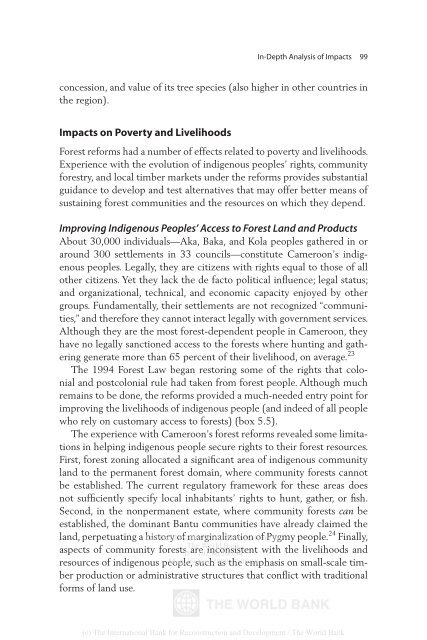The Rainforests of Cameroon - PROFOR
The Rainforests of Cameroon - PROFOR
The Rainforests of Cameroon - PROFOR
- No tags were found...
Create successful ePaper yourself
Turn your PDF publications into a flip-book with our unique Google optimized e-Paper software.
In-Depth Analysis <strong>of</strong> Impacts 99concession, and value <strong>of</strong> its tree species (also higher in other countries inthe region).Impacts on Poverty and LivelihoodsForest reforms had a number <strong>of</strong> effects related to poverty and livelihoods.Experience with the evolution <strong>of</strong> indigenous peoples’ rights, communityforestry, and local timber markets under the reforms provides substantialguidance to develop and test alternatives that may <strong>of</strong>fer better means <strong>of</strong>sustaining forest communities and the resources on which they depend.Improving Indigenous Peoples’ Access to Forest Land and ProductsAbout 30,000 individuals—Aka, Baka, and Kola peoples gathered in oraround 300 settlements in 33 councils—constitute <strong>Cameroon</strong>’s indigenouspeoples. Legally, they are citizens with rights equal to those <strong>of</strong> allother citizens. Yet they lack the de facto political influence; legal status;and organizational, technical, and economic capacity enjoyed by othergroups. Fundamentally, their settlements are not recognized “communities,”and therefore they cannot interact legally with government services.Although they are the most forest-dependent people in <strong>Cameroon</strong>, theyhave no legally sanctioned access to the forests where hunting and gatheringgenerate more than 65 percent <strong>of</strong> their livelihood, on average. 23<strong>The</strong> 1994 Forest Law began restoring some <strong>of</strong> the rights that colonialand postcolonial rule had taken from forest people. Although muchremains to be done, the reforms provided a much-needed entry point forimproving the livelihoods <strong>of</strong> indigenous people (and indeed <strong>of</strong> all peoplewho rely on customary access to forests) (box 5.5).<strong>The</strong> experience with <strong>Cameroon</strong>’s forest reforms revealed some limitationsin helping indigenous people secure rights to their forest resources.First, forest zoning allocated a significant area <strong>of</strong> indigenous communityland to the permanent forest domain, where community forests cannotbe established. <strong>The</strong> current regulatory framework for these areas doesnot sufficiently specify local inhabitants’ rights to hunt, gather, or fish.Second, in the nonpermanent estate, where community forests can beestablished, the dominant Bantu communities have already claimed theland, perpetuating a history Delivered <strong>of</strong> by marginalization <strong>The</strong> World Bank e-library <strong>of</strong> Pygmy to: people. 24 Finally,<strong>The</strong> World Bankaspects <strong>of</strong> community forests IP are : 192.86.100.34 inconsistent with the livelihoods andresources <strong>of</strong> indigenous people, Mon, 09 such Nov 2009 as the 17:06:18 emphasis on small-scale timberproduction or administrative structures that conflict with traditionalforms <strong>of</strong> land use.(c) <strong>The</strong> International Bank for Reconstruction and Development / <strong>The</strong> World Bank
















